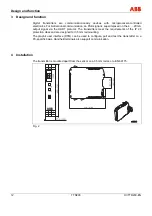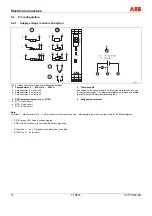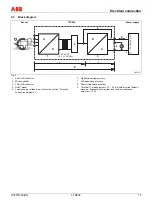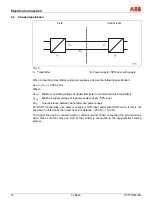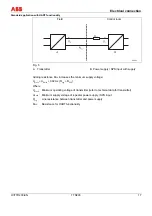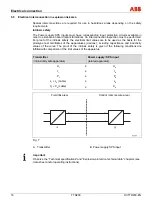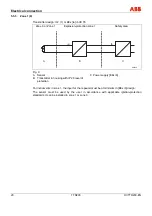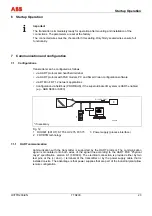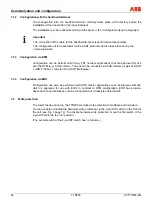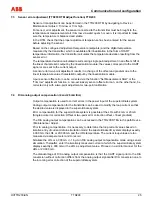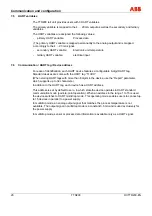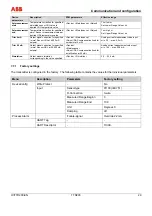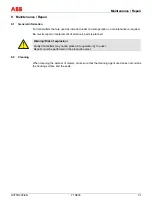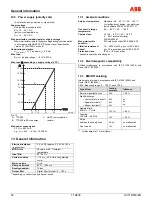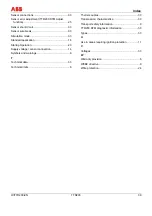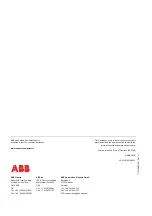
Communication and configuration
OI/TTR200-EN TTR200
25
Pos: 19.13.1 /Überschriften/1.1/1-spaltig/S - U/Sensorfehler-Abgleich ( DTM-Abgleich-Funktion) @ 15\mod_1195810105765_3101.doc @ 142413
7.3
Sensor error adjustment (TTR200 DTM Adjust function) TTR200
Pos: 19.13.2 /Konfiguration, Parametrierung/Temperatur/TTR200/Sensorfehler-Abgleich @ 15\mod_1195809415281_3101.doc @ 142390
Sensor error adjustment can be performed in the TTR200 DTM by navigating to Device /
Maintenance / Adjust / Trim low or Trim high.
For sensor error adjustment, the sensor connected to the transmitter must be brought to the
temperature at measurement start / trim low via water quench or oven. It is important to make
sure the temperature is balanced and stable.
In the DTM, check that the proper adjustment temperature has been entered for the sensor
before adjusting the sensor.
Based on the configured adjustment temperature (setpoints) and the digital temperature
measured by the transmitter, which is available after linearization in the form of HART
temperature information, the transmitter calculates the temperature deviation resulting from the
sensor error.
The temperature deviation calculated results during single point adjustment in an offset shift of
the linear characteristic output by the linearization module; the values correspond to the HART
signal or are sent to the current output.
A sensor error two-point adjustment results in a change of the offset and gradient due to the
linear temperature value characteristic output by the linearization module.
A pure sensor offset error can be corrected via the function “Set Measurement Start” or the
“Trim low” adjustment function. A non-exclusively sensor offset error can, on the other hand, be
corrected only with a two-point adjustment or two-point calibration.
Pos: 19.13.3 /Überschriften/1.1/1-spaltig/D - F/D/A-Analogausgangs-Abgleich (4 und 20 mA Trim) @ 8\mod_1174410063000_3101.doc @ 73783
7.4
D/A analog output compensation (4 and 20 mA trim)
Pos: 19.13.4 /Konfiguration, Parametrierung/Temperatur/TTR200/D/A-Analogausgangs-Abgleich (4 und 20 mA Trim) @ 15\mod_1195814050562_3101.doc @ 142437
Output compensation is used to correct errors in the power input of the superordinate system.
Analog output compensation for the transmitter can be used to modify the loop current so that
the desired value is displayed in the superordinate system.
Error compensation for the superordinate system is possible at the LRL with 4 mA or 20 mA.
(Single point error correction: Offset or two-point error correction linear gradient)
The D/A analog output compensation can be accessed in the TTR200 DTM via the path Device
/ Maintenance / Adjust.
Prior to analog compensation, it is necessary to determine the loop current values based on
iterative entry of current data in simulation mode; the superordinate I/O system displays exactly
4,000 mA, the LRL or 20,000 mA and the URL temperature. The current loop values are too
measured via ampere meter and to record.
Simulate the LRL or 4,000 mA +/- 16 µA in D/A analog output compensation mode using sensor
simulation. Thereafter, enter the iteratively measured current at which the superordinate system
displays exactly 4,000 mA or the LRL as adjustment value. Proceed in a similar manner for the
URL or 20,000 mA.
The disadvantage of D/A analog output compensation is that the HART signal prior to the D/A
conversion without correction differs from the analog output signal after D/A conversion due to
the incoming error correction of the superordinate system.
Pos: 19.13.6 /Überschriften/1.1/1-spaltig/G - I/HART-Variablen @ 16\mod_1199270968437_3101.doc @ 147260


